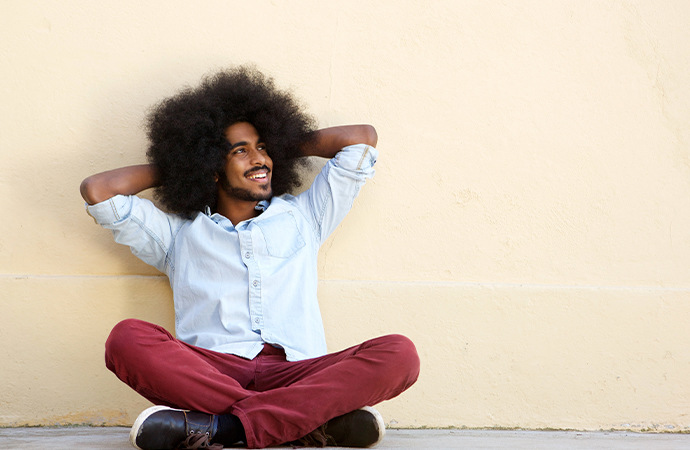Tips for effective hand poses and sitting poses.
Photographing human hands and seated people creates unique challenges in commercial and portrait photography. See how to overcome the awkwardness, bring out the best in your subjects, and create engaging posed photos.

Successful poses come from planning and trust.
Being able to instruct your subjects in how to sit or move their hands can make it easier for you to get the photos you need. Set yourself up for success by coming prepared with pose ideas, so your models feel good and you can focus on getting more shots.
Prepare yourself and your subjects.
Create a plan by deciding how you want your photos to look. Once you have a goal, you can brainstorm what poses will achieve the look. Next, prep your models. No one wants to be photographed when they’re unprepared, and nothing ruins good hand photography faster than chipped nail polish.
Get started by recruiting your loved ones to practice posing for you. It’s a low-stakes atmosphere where you can learn a lot.

A relaxed model is a good model.
“Build a space where your subject feels safe to make choices,” photographer and videographer Kenton Waltz recommends. A great pose is not just about moving your model into different positions; it’s about building trust. Set your model at ease by connecting with them. Be sure to get out from behind the camera occasionally to make eye contact. Encourage them to breathe and relax. Get them laughing to ease the mood.
- Shoot in rounds. During round one, get to know your model and allow them to move freely. During round two, adjust poses based on round one.
- Shake it out. Work with your model’s natural movements. Forced motions stick out. If poses start to feel stale, have the model get up, take some deep breaths, and reset. The same goes for hand positions.
- Use a simple prop. No one knows what to do with their hands in front of the lens, but everyone knows how to pick up a mug. Editorial photographer Nicolle Clemetson says, “Props are like a little crutch. It gives them something to fall back on.”
- Bring a friend. Bring in a movement coach to help. They can assist in directing poses and hand placement, while keeping track of small details, like out-of-place jewelry.
- Set the tone. Use your own body language to get what you want from your subject. To get your model to straighten their posture, straighten yours. “You’ve got to bring the emotion and gestures that you’re trying to create,” says Waltz.


Tips for hand poses.
The right hand pose adds a human element to a commercial shot or that extra something special to a standard portrait. The placement of hands in engagement or family photos can highlight emotional connections.
Here are some tips for successful hand posing:
- Be gentle. When hands are against the body, make sure they’re not pressing hard into the skin.
- Don’t hide them. When posing with hands in pockets, for example, leave a portion of the hand outside.
- Find a good angle. Avoid shooting the fingers directly facing the camera, since it will shorten them.
- Consider your distance. Don’t put hands closer to the camera than other body parts, unless you want them to appear larger.
- Use hands to highlight. Wherever the hand is resting will be accentuated. Using a hand to highlight the belly of a pregnant woman is one of many popular maternity poses.
- Keep it fresh. When one hand pose starts to stiffen, give the hand model a break and have them shake it out.
- Shoot shallow. Especially when you’re starting out, shoot in a shallow depth of field so you can focus on one detail at a time.
- Encourage natural movement. Get your subject to talk about something they love. “When they’re having fun, they’ll be gesturing with their hands,” Waltz explains.

Tips for seated poses.
Don’t tell subjects exactly how to position themselves when they first sit down. You want them to sit how they’re most comfortable, and then you can adjust them.
A few other things to keep in mind:
- Good posture is important. Have your subject lengthen their spine and relax their shoulders.
- Choose the right chair. The ideal chair encourages good posture, offers multiple ways to sit, and is the right height for your model’s feet to touch the ground.
- Aim for equal distance. Whatever is closest to the camera will appear larger, especially when shooting with a wide-angle lens. If the model is in a cross-legged pose or has their feet close to you, raise the camera and point it down diagonally, so the camera is equidistant from the feet and the face.
- Position people with care. Keep everyone at a relatively equal distance from the camera, unless you want to show off differences in size. This also goes for group photos like wedding shots or couple poses.
- Change your perspective. Sometimes changing your angle can be easier than changing a pose. Walk around and take photos of seated people from different directions.

Try and try again.
“We all shoot digital now for the most part. So just keep shooting,” says Clemetson. You can tether your camera in Adobe Lightroom while you shoot to see the photos pop up on your laptop screen. This makes it easier to spot small things that need adjusting as you go.
There will always be surprises in posed photography. But if you set yourself up with a plan, bring your positive energy, and make your models comfortable, you can adapt to what comes your way and capture compelling poses.
Contributors
Do more with Adobe Photoshop Lightroom.
Edit photos easily with Lightroom presets, Super Resolution, easily share photos from any device, and access your projects anywhere with cloud photo storage management.
You might also be interested in…
Creating great portrait photography.
Take a step closer to perfect portraits with tips and advice from professional photographers.
Discover how to capture all the scheduled and candid moments of the big day.
A good headshot tells a story. Here’s what you need to know to hone your skill in this field.
Understanding shallow depth of field.
Explore how shallow depth of field can add dimension to your photographs.



